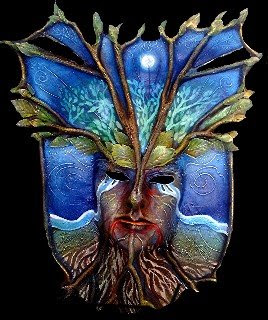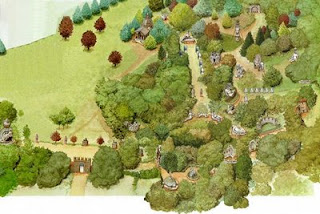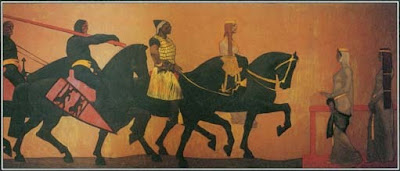
There are still a few places in the world where one can sense what Earth was like before the advent of humans. In the aisles of a tropical rainforest, such as the one that flourishes by the Rio Napo in Peru, there are so many species of trees that often one has to walk some distance before finding the same one twice, and the variety of iridescent butterflies, mantises and other insects is incredible. In a cave under the coastal cliffs of Oregon, open to the breakers of the seemingly changeless ocean, the great sea lions bark clouds of steam above pools where mussels and anemones cling amid a constantly moving throng of crustaceans. At evening in springtime around a desert water hole in Organ Pipe Cactus National Monument, Arizona, bright flowers spice the air as bighorn sheep lower their heads and bats dive to the surface, drinking on the wing. Earth before mankind was a place of abundant biodiversity and of dynamic balance among species and elements.
An environmental history has to begin with the environment. There is a history of the environment before the human species evolved into its present form. Indeed, the appearance of Homo sapiens came only recently in the long story of the Earth’s geology and biology, a story to which many scientists apply the term “environmental history” in a broader sense.
What is the natural state of Earth? This is a question that must be answered before it is possible to understand how the human species relates to, and changes, the natural world. Some early ecologists argued that selected areas ought to be preserved from virtually all human disturbance to show how natural living systems operate when compared with areas that have suffered from various kinds of interference. While it is even more important today to preserve habitats for animal and plant species, it is also increasingly apparent that no place on Earth is really unaffected by human activity; none has escaped such widespread effects as air pollution, intensification in the acidity of precipitation, radioactive fallout, and the penetration of ultraviolet radiation due to the depletion of the ozone layer in the high atmosphere. This means that historians must look to evidence from the deep past to find out how nature operated without humankind, and use that as a baseline or control against which to judge the changes brought about since the beginning of human history.
Contemplating the immense age that Earth had reached before humans appeared may provide perspective. The planet condensed into its nearly spherical shape, seas and continents formed, the phyla of the animal and vegetable kingdoms evolved, and living species evolved ways of interacting with the physical matrix and with each other over hundreds of millions of years. The result was an ecological balance that sustained the conditions for life. Natural laws may, according to the new views of cosmological physics, change as the universe unfolds, but they do not apparently make exceptions for individuals or species. Humans, whose written history has spanned only the last few thousand years, must live within the conditions of the physical and biological universe and take careful account of the balance that is the natural state of Earth.
Ecological balance is dynamic, not static. It operates through change. It is not rest, but harmony in movement. It is not the stable condition of block resting on block in a pyramid, nor the unstable equilibrium of scales where a weight added on one side will bring one arm down and the other up, but the poise of an eagle flying, adjusting her wings to carry her body evenly through shifting currents of air. A living creature allows for changes that come from inner states and outer forces, adapting to sustain its life.
The idea that the Earth is a living organism is very ancient. Such was the intuitive understanding of the earliest people whose thought can be fathomed, the tribal hunters and farmers. They regarded Earth as a mother, and worshipped her as a goddess. Plato and other Greek philosophers maintained that the cosmos is alive, as we, who are among its constituent parts, are alive. In the twentieth century, the atmospheric chemist James Lovelock enunciated a theory that all life on Earth acts together like a great living organism to influence temperature, atmospheric composition, and other physical factors so as to maintain optimum conditions for itself. As the name for this organism, Lovelock selected “Gaia,” the Greek name for the goddess Earth. This idea, called the Gaia hypothesis, is a seminal concept, but should be used critically and carefully. In what sense is Earth alive?
When we look at Earth as an entire planet, it does seem to be alive. Time-lapse films taken from artificial satellites show the great cycles of weather systems streaming like the currents of cytoplasm in a cell. The seas also circulate. Geologists have detected a much slower recycling called plate tectonics, in which the renewal of the sea beds, welling up from under the crust and being swallowed millions of years later by subduction back to underworld places of melting heat, moves the continental masses, splitting and joining, in ever-changing patterns. These look like living processes, and although the seas are, so far as we know, a unique feature of Earth, roughly similar atmospheric patterns appear on Venus and Jupiter, while some of the moons of the outer planets show evidence of plate tectonics, and these bodies are almost certainly not alive in the same sense as Gaia.
It can be maintained with good reason that the entire planet is alive, that just as a body includes seemingly nonliving parts like bones and blood serum, so a living planet includes air, sea, and rocks. Ecological science shows us how animals and plants interact with each other and their environments, forming larger units called ecosystems. Through reproduction, the food chain, and the cycles of elements and energy, in an immensely complex set of relationships, species increase and decrease in number, but the ecosystem as a whole continues. In this sense, ecosystems are organisms, and Gaia, or the biosphere of Earth, is the largest ecosystem. This does not mean, however, that Gaia is an organism in just the same way that the human body is an organism. To explain this, one can look at the relationship between a single cell and the body. Both are alive, but the body is not just a large cell. The body is an immense community of living cells, related to one another in myriads of ways. The whole is greater than the sum of parts. Similarly, Gaia is a community that includes billions of living bodies, but the structure of that living community is much more complex than that of the body, as the structure of the body is more complex than that of the cell. The body is a somatic organism, but Gaia is an ecological organism. Thus defined, Gaia is much more than a metaphor. The physiological processes of Gaia are the interrelationships defined and studied by ecology.
It is possible to examine the natural state of Earth in realistic ecological terms. Though it was undeniably less polluted and more profuse in living things than today, Earth before humans was not a boring Eden. There were sudden and immense changes: volcanic eruptions, earthquakes, tsunamis, tornadoes, forest fires, floods and droughts. The wounds left by these soon healed, as life, often finding the devastated areas enriched by mineral and organic deposits, reclaimed them in the stages of natural succession. Great changes were wrought by the working of the ecological processes themselves. The populations of some species built up cyclically to insupportable numbers, depleting their food supplies, and then suddenly declined. Some species became extinct while others evolved. There were those that, like beavers and termites, greatly altered their environments over large areas. But changes prepared the way for new forms of life. Life was sustainable and, above all, abundant. The air thronged with billions of birds, compared to which the present avian population is a sad remnant. The plains themselves must have seemed to move with herds of herbivores, followed by their predators. Schools of fish silvered the sea, while the great whales rejoiced in numbers unseen in more modern times. Even in the late twentieth century, one could still gain an idea of what the primal state of Earth was like by visiting the savannas of East Africa or bird colonies on isolated islands. Although these regions are still impressive, they have suffered diminution, and some degree of imagination is necessary to appreciate the abundance and diversity of life as it existed before humans evolved.
LINK









